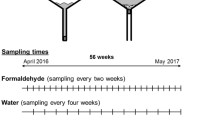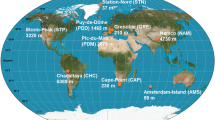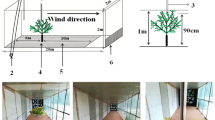Abstract
It is well known that microbes can be carried on the wind from one leaf to another, whether those leaves are centimeters or hundreds of kilometers apart. Each step in the dispersal sequence, take-off—transport—deposition, is influenced by atmospheric behavior. For leaves where takeoff is occurring, the atmosphere is a sink; conversely, where landing is occurring, it is a source. In this chapter we will review our understanding of the influences of atmospheric behavior on passive dispersal of windborne microbes. Neither dispersal involving vectors such as insects and humans, nor active dispersal such as the discharge of fungal spores into the air from fruiting bodies is considered. Most research has been concerned with microbes that cause disease in crop plants but many of the results should be applicable to other organisms, such as pollen and yeasts.
Access this chapter
Tax calculation will be finalised at checkout
Purchases are for personal use only
Preview
Unable to display preview. Download preview PDF.
Similar content being viewed by others
References
Amiro, B.D. and Davis, P.A. 1988. Statistics of atmospheric turbulence within a natural black spruce canopy. Boundary-Layer Meteorology 44:267–283.
Arkin, G.F. and Perrier, E.R. 1974. Vorticular air flow within an open row crop canopy. Agricultural Meteorology 13:359–374.
Aylor, D.E. 1975. Deposition of particles in a plant canopy. Journal of Applied Meteorology 14:52–57.
Aylor, D.E. 1978. Dispersal in time and space: aerial pathogens, pp. 159–180 in Horsfall, J.G. and Cowling, E.B. (editors), Plant Disease: an Advanced Treatise, vol. II. Academic Press, New York.
Aylor, D.E. 1982. Modeling spore dispersal in a barley crop. Agricultural Meteorology 26:215–219.
Aylor, D.E. 1986. A framework for examining inter-regional aerial transport of fungal spores. Agricultural and Forest Meteorology 38:263–288.
Aylor, D.E. 1989. Aerial spore dispersal close to a focus of disease. Agricultural and Forest Meteorology 47:109–122.
Aylor, D.E. and Parlange, J.-Y. 1975. Ventilation required to entrain small particles from leaves. Plant Physiology 56:97–99.
Aylor, D.E., McCartney, H.A., and Bainbridge, A. 1981. Deposition of particles liberated in gusts of wind. Journal of Applied Meteorology 20:1212–1221.
Baldocchi, D.D. and Meyers, T.P. 1988. Turbulence structure in a deciduous forest. Boundary-Layer Meteorology 43:345–364.
Bergen, J.D. 1975. Air movement in a forest clearing as indicated by smoke drift. Agricultural Meteorology 15:165–179.
Bertrand, P.F. and English, H. 1976. Release and dispersal of conidia and ascospores of Valsa leucostoma. Phytopathology 66:987–991.
Brennan, R.M., Fitt, B.D.L., Taylor, G.S., and Colhoun, J. 1985a. Dispersal of Septoria nodorum pycnidiospores by simulated raindrops in still air. Phytopathologische Zeitschrift 112:281–290.
Brennan, R.M., Fitt, B.D.L., Taylor, G.S., and Colhoun, J. 1985b. Dispersal of Septoria nodorum pycnidiospores by simulated rain and wind. Phytopathologische Zeitschrift 112:291–297.
Carnegie, S.F. 1980. Aerial dispersal of the potato gangrene pathogen, Phoma exigua var. foveata. Annals of Applied Biology 94:165–173.
Chamberlain, A.C. and Little, P. 1981. Transport and capture of particles by vegetation, pp. 147–173 in Grace, J., Ford, E.D., and Jarvis, P.G. (editors), Plants and Their Atmospheric Environment. Blackwell, Oxford.
Chock, D.P. and Kuo, Y.H. 1990. Comparison of wind-field models, using the CAPTEX data. Journal of Applied Meteorology 29:76–91.
Clarke, J.F., Clark, T.L., Ching, J.K.S., Haagenson, P.L., Husar, R.B., and Patterson, D.E. 1983. Assessment of model simulation of long-distance transport. Atmospheric Environment 17:2449–2462.
Davis, J.M. 1987. Modeling the long-range transport of plant pathogens in the atmosphere. Annual Review of Phytopathology 25:169–188.
Davis; J.M. and Main, C.E. 1984. A regional analysis of the meteorological aspects of the spread and development of blue mold on tobacco. Boundary-Layer Meteorology 28:271–304.
Davis, J.M. and Main, C.E. 1989. The aerobiology of the sporangiospores of Peronospora tabacina. pp. 264–267 in 9th Conference of Biometeorology and Aerobiology. American Meteorological Society, Boston.
Davis, J.M., Main, C.E., and Nesmith, W.C. 1985. The biometeorology of blue mold of tobacco: Part 2. The evidence for long-rang sporangiospore transport, pp. 473–498 in MacKenzie, D.R., Barfield, C.S., Kennedy, G.G., Berger, R.D., and Toranto, D.J. (editors), The Movement and Dispersal of Agriculturally Important Biotic Agents. Claitor’s Publishing Division, Baton Rouge, LA.
Dinoor, A. 1981. Epidemics caused by fungal pathogens in wild and crop plants, pp. 143–158 in Thresh, J.M. Plant Pathogens and Vegetation. Pitman, Boston.
Drinikall, M.J. and Price, T.V. 1983. Dispersal of Synchytrium psophocarpi in Papua New Guinea. Plant Pathology 32:229–237.
Ferrandino, F.J. and Aylor, D.E. 1985. Deposition of particles to a wheat canopy: the importance of inertial impaction. Agricultural and Forest Meteorology 34:195–204.
Fitt, B.D.L. and Bainbridge, A. 1983. Dispersal of Pseudocercosporella herpotrichoides spores from infected wheat straw. Phytopathologische Zeitschrift 106:214–225.
Fitt, B.D.L. and Lysandrou, M. 1984. Studies on mechanisms of splash dispersal of spores, using Pseudocercosporella herpotrichoides spores. Phytopathologische Zeitschrift 111:323–331.
Fitt, B.D.L., McCartney, H.A., and Walklate, P.J. 1989. The role of rain in dispersal of pathogen inoculum. Annual Review of Phytopathology 27:241–270.
Foster, G.F. 1977. Effect of leaf surface wax on the deposition of airborne propagules. Transactions of the British Mycological Society 68:245–250.
Gao, W., Shaw, R.H., and Paw U, K.T. 1989. Observation of organised structure in turbulent flow within and above a forest canopy. Boundary-Layer Meteorology 47:349–377.
Gottwald, T.R. 1983. Factors affecting spore liberation by Cladosporium carpophilum. Phytopathology 73:1500–1505.
Graham, D.C. and Harrison, M.D. 1975. Potential spread of Erwinia spp. in aerosols. Phytopathology 65:739–741.
Gregory, P.H., Griffin, M.J., Maddison, A.C., and Ward, M.R. 1984. Cocoa black pod: a reinterpretation. Cocoa Growers’ Bulletin 35:5–22.
Griffiths, E. and Ao, H.C. 1976. Dispersal of Septoria nodorum spores and spread of glume blotch of wheat in the field. Transactions of the British Mycological Society 67:413–418.
Hammett, K.R.W. and Manners, J.G. 1974. Conidium liberation in Erysiphe graminis: III. Wind tunnel studies. Transactions of the British Mycological Society 62:267–282.
Harrison, M.D. and Brewer, J.E. 1982. Field dispersal of soft rot bacteria, pp. 31–53 in Mount, M.S. and Lacy, G.H. (editors), Phytopathogenic Prokaryotes. Academic Press, New York.
Heffter, J.L. 1980. Air Resources Laboratories atmospheric transport and dispersion model. NOAA Technical Memorandum ERL-ARL-81.
Heffter, J.L. 1983. Branching atmospheric trajectory model. NOAA Technical Memorandum. ERL-ARL-121.
Hermansen, J.E., Torp, U., and Prahm, L.P. 1978. Studies of transport of live spores of cereal mildew and rust fungi across the North Sea. Grana 17:41–46.
Hirst, J.M. and Stedman, O.J. 1963. Dry liberation of fungal spores by raindrops. Journal of General Microbiology 33:335–344.
Hirst, J.M. and Stedman, O.J. 1971. Patterns of spore dispersal in crops, pp. 229–237 in Preece, T.F. and Dickinson, C.H. (editors), Ecology of Leaf Surface Microorganisms. Academic Press, New York.
Kuske, C.R. and Benson, D.M. 1983. Survival and splash dispersal of Phytophthora parasitica, causing dieback in Rhododendron. Phytopathology 73:1188–1191.
Lacy, M.L. and Pontius, G. A. 1983. Prediction of weather-related release of conidia of Botrytis squamosa from onion leaves in the field. Phytopathology 73:670–676.
Legg, B.J. 1983. Movement of plant pathogens in the crop canopy. Philosophical Transactions of the Royal Society of London B302:559–574.
Legg, B.J. and Powell, F.A. 1979. Spore dispersal in a barley crop: a mathematical model. Agricultural Meteorology 20:47–67.
Lindemann, J. and Upper, C.D. 1985. Aerial dispersal of epiphytic bacteria over bean plants. Applied Environmental Microbiology 50:1229–1232.
Lindemann, J., Constantinidou, H.A., Barchet, W.R., and Upper, C.D. 1982. Plants as sources of airborne bacteria, including ice nucleation-active bacteria. Applied Environmental Microbiology 44:1059–1063.
Little, P. 1977. Deposition of 2.75, 5.0 and 8.5 μm particles to plant and soil surfaces. Environmental Pollution 12:293–305.
MacDonald, O.C. and McCartney, H.A. 1988. A photographic technique for investigating the splashing of water drops on leaves. Annals of Applied Biology 113:627–638.
Main, C.E. and Davis, J.M. 1989. Epidemiology and biometeorology of tobacco blue mold. pp. 201–215 in McKeen, W.E. (editor), Blue Mold of Tobacco. Amer. Phytopathol. Soc.
McCartney, H.A. and Aylor, D.E. 1987. Relative contributions of sedimentation and impaction to deposition of particles in a crop canopy. Agricultural and Forest Meteorology 40:343–358.
McCartney, H.A. and Fitt, B.D.L. 1985. Construction of dispersal models. Advances in Plant Pathology 3:107–143.
McEwan, J.M. 1966. The source of stem-rust infecting New Zealand wheat crops. New Zealand Journal of Agricultural Research 9:536–541.
Moore, W.F. 1970. Origin and spread of southern corn leaf blight in 1970. Plant Disease Reporter 54:1104–1108.
Nagarajan, S. and Joshi, L.M. 1980. Further investigations on predicting wheat rusts appearance in central and peninsular India. Phytopathologische Zeitschrift 98:84–90.
Nagarajan, S. and Joshi, L.M. 1985. Epidemiology in the Indian subcontinent. pp. 371–402 in Roelfs, A.P. and Bushneil, W.R. (editors), The Cereal Rusts. Academic Press, New York.
Nagarajan, S. and Singh, H. 1976. Preliminary studies on forecasting wheat stem rust appearance. Agricultural Meteorology 17:281–289.
Nagarajan, S., Singh, H., Joshi, L.M., and Saari, E.E. 1976. Meteorological conditions associated with long-distance dissemination and deposition of Pucciniagraminis tritici uredospores in India. Phytopathology 66:198–203.
Orlanski, I. 1975. A rational subdivision of scales for atmospheric processes. Bulletin of the American Meteorological Society. 56:527–530.
Pack, D.H., Ferber, G.J., Hefter, J.L., Telegadas, S.K., Angell, J.K., Hoecker, W.H., and Machta, L. 1978. Meteorology of long-range transport. Atmospheric Environment 12:426–444.
Pasquill, F. and Smith, F.B. 1983. Atmospheric Diffusion, 3rd edition. Ellis Horwood, Chichester, UK.
Pedgley, D.E. 1986. Long distance transport of spores, pp. 346–365 in Leonard, K.J. and Fry, W.E. (editors), Plant Disease Epidemiology, vol. I. McGraw Hill, New York.
Purdy, L.H. 1985. Sugarcane rusts, pp. 237–256 in Roelfs, A.P. and Bushnell, W.R. (editors), The Cereal Rusts. Academic Press, New York.
Quinn, C.E., Sells, I.A., and Graham, D.C. 1980. Soft rot Erminia bacteria in the atmospheric bacterial aerosol. Journal of Applied Bacteriology 49:175–181.
Quinn, N.W. and Laflen, J.M. 1983. Characteristics of raindrop throughfall under corn canopy. Transactions of the ASAE 26:1445–1450.
Raupach, M.R. and Thorn, A.S. 1981. Turbulence in and above plant canopies. Annual Review of Fluid Mechanics 13:97–129.
Ray, P.S. (editor). 1986. Mesoscale Meteorology and Forecasting. American Meteorological Society, Boston. 793pp.
Reisinger, L.M. and Mueller, S.F. 1983. Comparison of tetroon and computed trajectories. Journal of Climate and Applied Meteorology 22:664–672.
Sawford, B.L. 1987. Conditional concentration statistics for surface plumes in the atmospheric boundary layer. Boundary-Layer Meteorology 38:209–223.
Scott, R.W. and Achtemeier, G.L. 1987. Estimating pathways of migrating insects carried in atmospheric winds. Environmental Entomology 16:1244–1254.
Shaw, M.W. 1987. Assessment of upward movement of rain splash using a fluorescent tracer method and its application to the epidemiology of cereal pathogens. Plant Pathology 36:201–213.
Shaw, R.H. 1982. Wind movement within canopies, pp. 17–41 in Hatfield, J.L. and Thomason, I.J. (editors), Biometeorology in Integrated Pest Management. Academic Press, New York.
Shaw, R.H., Ward, D.P., and Aylor, D.E. 1979. Frequency of occurrence of fast gusts of wind inside a corn canopy. Journal of Applied Meteorology 18:167–171.
Smith, F.B. 1983. Meteorological factors influencing the dispersion of airborne diseases. Philosophical Transactions of the Royal Society of London B302:439–450.
Stakman, E.C. and Christensen, C.M. 1946. Aerobiology in relation to plant disease. Botanical Review 12:205–253.
Starr, J.R. 1967. Deposition of particulate matter by hydrometeors. Quarterly Journal of the Royal Meteorological Society 93:516–521.
Starr, J.R. and Mason, B.J. 1966. The capture of airborne particles by water drops and simulated snow crystals. Quarterly Journal of the Royal Meteorological Society 92:490–499.
Stocker, R.A., Pielke, R.A., Verdon, A.J., and Snow, J.T. 1990. Characteristics of plume releases as depicted by balloon launchings and model simulations. Journal of Applied Meteorology 29:53–62.
Stover, R.H. 1962. Intercontinental spread of banana leaf spot (Mycosphaerella musicala Leach). Tropical Agriculture, Trinidad 39:327–338.
Stow, C.D. and Stainer, R.D. 1977. The physical products of a splashing water drop. Journal of the Meteorological Society of Japan 55:518–532.
Subba Rao, K.V., Snow, J.P., and Berggren, G.T. 1989. Detection, viability, and possible sources of uridiniospores of Puccinia recondita f. sp. tritici in Louisiana. Plant Disease 73:437–442.
Ulbrich, C.W. 1983. Natural variations in the analytical form of the raindrop size distribution. Journal of Climate and Applied Meteorology 22:1764–1775.
Venette, J.R. 1982. How bacteria find their hosts, pp. 3–30 in Mount, M.S. and Lacy, G.H. (editors), Phytopathogenic Prokaryotes. Academic Press, New York.
Waggoner, P.E. 1983. The aerial dispersal of the pathogens of plant disease. Philosophical Transactions of the Royal Society of London B302:451–462.
Walklate, P.J. 1987. A random-walk model for dispersion of heavy particles in turbulent air flow. Boundary-Layer Meteorology 39:175–190.
Walklate, P.J. 1989. Vertical dispersal of plant pathogens by splashing. Part I: the theoretical relationship between rainfall and upward rain splash. Plant Pathology 38:56–63.
Walklate, P.J., McCartney, H.A., and Fitt, B.D.L. 1989. Vertical dispersal of plant pathogens by splashing. Part II: experimental study of the relationship between raindrop size and maximum splash height. Plant Pathology 38:64–70.
Waller, J.M. 1976. The influence of climate on the incidence and severity of some diseases of tropical crops. Review of Plant Pathology 55:185–194.
Waller, J.M. 1979. The recent spread of coffee rust (Hemileia vastatrix) and attempts to control it. pp. 275–283 in Ebbels, D.L. and King, J.E. (editors), Plant Health. Blackwell, Oxford.
Watson, I.A. and de Sousa, C.N.A. 1983. Long distance transport of spores of Puccinia graminis tritici in the southern hemisphere. Proceedings of the Linnean Society of New South Wales. 106:311–321.
Weil, J.C. 1985. Updating applied diffusion models. Journal of Climate and Applied Meteorology 24:1111–1130.
Weiss, A. and Allen Jr, L.H. 1976. Air-flow patterns in vineyard rows. Agricultural Meteorology 16:329–342.
Editor information
Editors and Affiliations
Rights and permissions
Copyright information
© 1991 Springer-Verlag New York Inc.
About this paper
Cite this paper
Pedgley, D.E. (1991). Aerobiology: The Atmosphere as a Source and Sink for Microbes. In: Andrews, J.H., Hirano, S.S. (eds) Microbial Ecology of Leaves. Brock/Springer Series in Contemporary Bioscience. Springer, New York, NY. https://doi.org/10.1007/978-1-4612-3168-4_3
Download citation
DOI: https://doi.org/10.1007/978-1-4612-3168-4_3
Publisher Name: Springer, New York, NY
Print ISBN: 978-1-4612-7822-1
Online ISBN: 978-1-4612-3168-4
eBook Packages: Springer Book Archive




